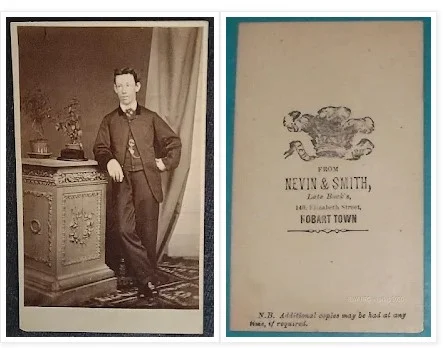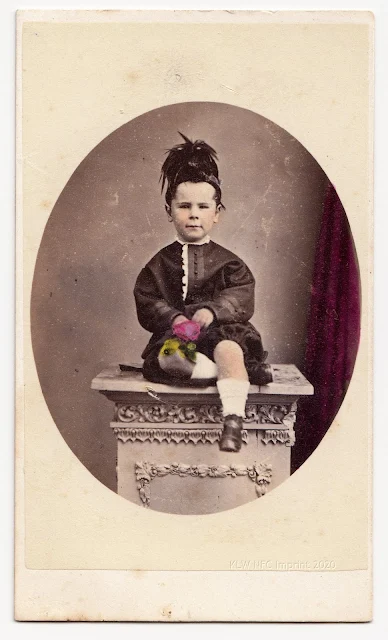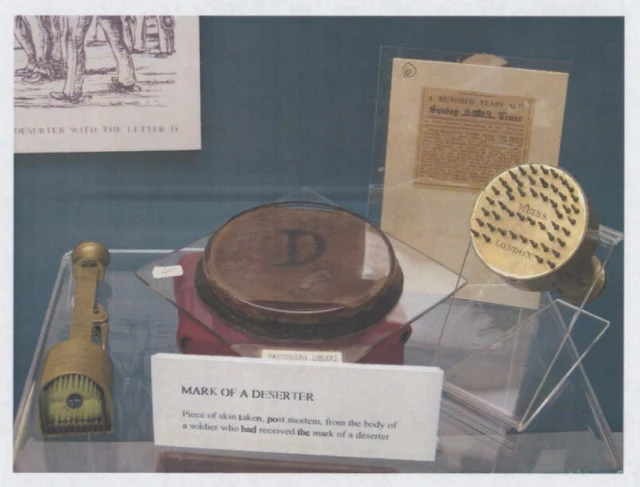Portraits of children by Thomas J. NEVIN 1860s-1870s
T. J. NEVIN's carte-de-visite portraits held in Lucy Batchelor's Album 1892
Thomas J. Nevin's full-length studio portraits
The ten or so pieces of furniture listed below appeared frequently in Thomas Nevin's commercial studio portraits. If you find they were useful to you in terms of identifying the photographer, the date and place the photograph was taken, and even the identity of the sitters when wondering if there is more to find out about your old (family) photographs from the 1860s-1870s, let us know here. Tinting the print and pasting it to a plain buff mount also characterised Nevin's practice in those years.

Thomas J. Nevin's studio decor items and printing preferences 1870s:
Tapis floor covering, dining chair, drape, backdrop with vista, tinting, eyepricks, book, plain mount
Alfred Barrett Biggs ca, 1872-4 (ca. 45 yrs)
Photographer : Thomas J. Nevin, City Photographic Establishment, Hobart (verso stamp)
Source: Archives Office of Tasmania
View online: LMSS754-1-9
Objects
1. the plinth
2. the shiny slipper chair
3. the drape, sometimes coloured crimson
4. the canvas backdrop featuring a painted Italianate patio and a cart path or stream disappearing to distant mountains on a low horizon
5. the wooden table with griffin-shaped legs
6. a book or tinted flowers in vase on the table with griffin-shaped legs
7. the big box table-top stereoscopic viewer on the table with griffin-shaped legs
8. the thick shag carpet with diamond pattern
9. the thin tapis floor covering with chain link and diamond pattern
10. the dining chair with ornate carved back
Prints
1. tinting of the sitters' clothing, headwear, cheeks, lips, pinpoints in eyes
2. the sepia print pasted on a plain buff rectangular mount without a studio mark on front
The Plinth
Plinths were standard studio furniture in commercial portraiture of the 1860s-1870s. Not just decorative, they were essentially a solid object at waist height where the standing subject could place a hand to hold themselves steady while waiting a minute or so for exposure of their image on the glass negative. The plinth was a far more attractive proposition for a person standing than the metal headrest holding the back of the neck.
There appears to be just one plinth featured in several portraits of children and young adults taken by Thomas J. Nevin in his studio at 140 Elizabeth St. Hobart during the late 1860s-mid 1870s. At least two sides of the plinth differed in small details of decoration. Damage to the plinth visible in these cdv's include cracks through the top and plaster broken off the corners.
DIAGONAL VIEW: full-length portrait by Thomas J. Nevin
Thomas Nevin took this full-length portrait of his younger brother Jack Nevin (1852-1891) posed leaning on a corner of the plinth in 1868 while in partnership with Robert Smith, operating as the firm Nevin & Smith at the studio, 140 Elizabeth St. Hobart Town, formerly leased by photographer Alfred Bock from builder Abraham Biggs.
The diagonal positioning of the plinth with the triangular point where two adjacent sides face the viewer would have created an empty space above the plinth top, resolved to some extent by the added elements of two pot plants and Jack's new hat. Each side of the plinth shows different plaster decorations running under the top and inside and along the edge of the cartouches. The side closest to Jack Nevin shows a single leaf motif under the top and a large floral wreath in relief enclosed in the cartouche; the other side shows a double line of motifs under the top and a smaller ring in relief at the centre of the cartouche. The point or corner at which the two sides meet under the top is broken off. In Nevin's portrait of the (Del Sarte) boy (below), the broken corner is clearly visible near his left foot.


Subject: William John Nevin (1852-1891), known as Jack to the family; also known as Constable John Nevin from 1870-1891.
Photographers: Thomas J. Nevin (older brother) and Robert Smith, as the firm Nevin & Smith.
Location and Date: 140 Elizabeth St. Hobart, Tasmania, January 1868.
Details: verso stamped with the Prince of Wales blazon of three feathers, coronet and Ich Dien;
"From Nevin & Smith late Bock's, 140 Elizabeth St. Hobart Town"
Source: Private Collection, Sydney Rare Books Auction, June 2019
PARTIAL VIEW: full-length portrait by Alfred Bock
Thomas J. Nevin acquired the plinth from Alfred Bock's auction of his studio furniture and stock-in-trade on Bock's insolvency and departure to Victoria in 1867. The plinth in this full-length portrait of Elizabeth Bayles shows the same side with its cartouche enclosing a large wreath as the side closest to Jack Nevin's figure in Thomas Nevin's portrait. In Bock's portrait of Elizabeth Bayles, a partial view of the plinth on right of frame afforded a full view of her voluminous dress. Another partial view of a smaller plinth on left of frame was placed there perhaps for balance, or simply to hold the drape up and off the floor .


Subject: Elizabeth Bayles
Photographer: Alfred Bock ca. 1864
Location: 140 Elizabeth St. Hobart Town, Tasmania
Details: full-length carte-de-visite
Verso bears Alfred Bock's stamp with kangaroo atop a circular belt
Copyright © KLW NFC Imprint Private Collection 2020.
FULL-FRONTAL VIEWS: children's portraits by Thomas J. Nevin
These three portraits of young children posed on top of the plinth show the variations on at least two sides of the plinth visible in Thomas J. Nevin's portrait of his brother Jack (above). All three children were arranged in the same pose, right leg tucked under left, facing front.
The Del Sarte family child
The first, bearing Nevin's studio stamp, was sourced commercially from a dealer and is now in the private collection of the KLW NFC Group. Undeniably one of Thomas J. Nevin's finest portraits of children, this exquisite cdv of an unidentified young child - who is likely to be male rather than female and possibly one of three sons of the Del Sarte (or Delsarte) family - was taken between 1868 and 1874 at Nevin's studio, the City Photographic Establishment, 140 Elizabeth St. Hobart Town, Tasmania.
The plinth on which the boy is posed shows the cartouche on the side with the small floral ring, the side that also appears closest to left side of frame in Thomas Nevin's cdv of his brother Jack (above). It is identifiable in each photograph from the missing piece of decorative plaster under the top, which on this side is near the boy's left foot.

Subject: Young boy ca. 3 yrs old, unidentified but possibly Camille Frederick Charles Del Sarte. (jnr)
He is wearing a costume jacket, bloomers, white socks and a feathered hat, perched on a plinth, holding a rose.
Photographer: Thomas J. Nevin (1842-1923)
Location: City Photographic Establishment, 140 Elizabeth St. Hobart Town, Tasmania.
Date: ca. 1868-1874
Details: Carte-de-visite albumen print in buff oval mount (103 x 63 mm); light colouring of boy's cheeks and pink and green of the rose he is holding. Drape to viewer's right coloured deep maroon.
Provenance: Douglas Stewart Fine Books ex "Parisian photography dealer".
Copyright © KLW NFC Imprint 2020 Private Collection. Watermarked.

Verso: note the light splattering of red watercolour from application of same to the rose and drape recto.
This photograph carries Thomas Nevin's most common commercial studio stamp which he modified only slightly from the design of Alfred Bock's stamp when he acquired Bock's lease of the studio and glasshouse in 1867.
He continued with its use despite the wording - "T. Nevin late A. Bock" - right through to early 1876 when he quit the studio in Elizabeth Street.
Subject: Young boy ca. 3 yrs old, unidentified but possibly Camille Frederick Charles Del Sarte. (jnr)
He is wearing a costume jacket, bloomers, white socks and a feathered hat, perched on a plinth, holding a rose.
Photographer: Thomas J. Nevin (1842-1923)
Location: City Photographic Establishment, 140 Elizabeth St. Hobart Town, Tasmania.
Date: ca.1876
Details: Carte-de-visite albumen print in buff oval mount (103 x 63 mm); light colouring of boy's cheeks and pink and green of the rose he is holding. Drape to viewer's right coloured deep maroon.
Provenance: Douglas Stewart Fine Books ex "Parisian photography dealer".
Copyright © KLW NFC Imprint 2020 Private Collection. Watermarked.
The Batchelor family children
The other two cdv portraits of young children sitting on the same plinth have not been removed since placed inside the album's gold leaf frames in Lucy Caroline Batchelor's album dated 1892, so there is yet no confirmation of an identifying mark or studio stamp, if any, on the versos. But because of their remarkable similarity to the above cdv by Thomas J. Nevin of the (Del Sarte) boy, they were most likely taken by him, whether of two unidentified brothers in the same session who exchanged the same jacket for their sitting, or of the same child taken a year or so apart.

Subject: Young boy ca. 3-4 yrs old, unidentified, sitting right leg tucked under his left, perched on a plinth. His serious gaze, mouth slightly open, is directed slightly to right of frame.
He wears a suit, a matching jacket embroidered with a design on the arms, a white kerchief in breast pocket, a waistcoat, bowtie lightly tinted blue, knee-length pants with frilled cuffs at the knees, white stockings and dark ankle boots. His hair is quiffed on top and parted on both sides.
Photographer: Thomas J. Nevin (1842-1923) - probable
Location: City Photographic Establishment, 140 Elizabeth St. Hobart Town, Tasmania.
Date: ca. 1868-1876
Details: Carte-de-visite albumen print in buff oval mount (103 x 63 mm), housed in a 19th century family album leaf in a gold frame.
Provenance: Complete album Google app album (you need a gmail acc)
Link: https://photos.app.goo.gl/oQ9pfRPdrQqCWUJ97
Copyright © Lucy Batchelor Album 1892, in the private collection of Peter and Robyn Bishop 2009

Subject: Young boy ca. 3 yrs old, unidentified, sitting on a large pillow lightly tinted red, his right leg tucked under his left, perched on a plinth. His gaze is direct to camera.
He wears a dark jacket embroidered with a design on the arms, a waistcoat, a bowtie lightly tinted in blue, light-coloured knee-length pants with white stockings and dark ankle boots His hair is flat on top and parted on his left.
Photographer: Thomas J. Nevin (1842-1923) - probable
Location: City Photographic Establishment, 140 Elizabeth St. Hobart Town, Tasmania.
Date: ca. 1868-1876
Details: Carte-de-visite albumen print in buff oval mount (103 x 63 mm), housed in a 19th century family album leaf in a gold frame, slightly askew.
Provenance: Complete album Google app album (you need a gmail acc)
Link: https://photos.app.goo.gl/oQ9pfRPdrQqCWUJ97
Copyright © Lucy Batchelor Album 1892, in the private collection of Peter and Robyn Bishop 2009
Older generation: Caroline Elliott & James Batchelor
The similarities with this photograph of Caroline Elliott & James Batchelor, parents or possibly grand parents of the two Batchelor boys (above) in terms of hand-tinting and the backdrop which, although faded, looks like Nevin's Italianate patio, arch and vista etc, suggests their portrait was also taken by Thomas J. Nevin.

Subjects: Caroline Elliott and James Batchelor
Photographer: Thomas J. Nevin (1842-1923) - probable
Location: City Photographic Establishment, 140 Elizabeth St. Hobart Town, Tasmania.
Date: ca. 1868-1876
Details: Full-length carte-de-visite albumen print in buff oval mount (103 x 63 mm), housed in a 19th century family album leaf in a gold frame. Hand-tinted blue on the neck ties of both Caroline and James, and pink on the flowers
Provenance: Complete album Google app album (you need a gmail acc)
Link: https://photos.app.goo.gl/oQ9pfRPdrQqCWUJ97
Copyright © Lucy Batchelor Album 1892, in the private collection of Peter and Robyn Bishop 2009
This cdv of Caroline and James Batchelor appears in a gold frame album leaf next to the boy's cdv (see directly above) in the order in which Lucy Batchelor placed them back in 1892.
Other portraits by Thomas J. Nevin in Lucy Batchelor's album
Several more cdv's in Lucy Batchelor's album are identifiable as the work of Thomas J. Nevin, firstly in terms of his studio stamp on verso; secondly, by the items of studio decor apart from the plinth, including his slipper chair and big box tabletop stereoscopic viewer; and thirdly, by his characteristic methods of printing and hand-colouring.






Carte-de-visite portraits by Thomas J. Nevin, Tasmania, 1870s
Copyright © Lucy Batchelor Album 1892, in the private collection of Peter and Robyn Bishop 2009
RELATED POSTS main weblog
- Portraits by T.J. Nevin in The Lucy Batchelor Collection
- Clients posing with Thomas J. Nevin's big box stereoscopic viewer
- Thomas J. Nevin at his finest: Camille Del Sarte and family 1860s-1870s
- Alfred Bock and the Bayles sisters
- Thomas Nevin and Alfred Barrett Biggs 1872-1876
- With Alfred Bock at The City Photographic Establishment
- Studio decor: table with griffin-shaped legs
- Studio decor: the pauper on Thos Nevin’s carpet and Brother Payne
- Lost originals: the Nevin, Genge and Chandler family photographs













.jpg)












